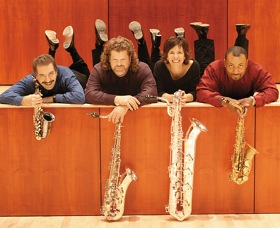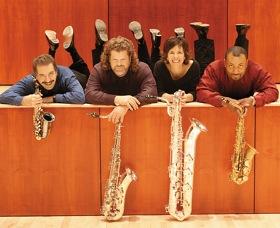
The surprise comes when people discover that the NCSQ is a bona fide classical ensemble. Its big break came in 1991, when it won first prize in the Concerts Artists Guild Competition. A few years later, the group began an active arranging and commissioning project that has spawned works by Peter Schickele, Sherwood Shaffer, Arthur Frackenpohl, David Ott, Ben Johnston, Benjamin Boone, Ken Valitsky, Thomas Massella, tenor saxophonist and Saturday Night Live band leader Lenny Pickett, and jazz saxophonist Bob Mintzer. If those aren’t all household names, neither is the saxophone.
Part of NCSQ’s challenge is that the saxophone is a relatively young instrument. Its inventor, Antoine-Joseph (Adolphe) Sax, first showed his baby to a friend, the composer Hector Berlioz, in 1841. Three years later, around the same time that Sax unveiled the instrument at the Paris Industrial Exhibition, Berlioz conducted a performance of his choral work Chant Sacre and included a saxophone in the orchestration. In 1846, Sax secured patents for 14 various models of saxophone, ranging from the E-flat sopranino to the F contrabass. He further refined his instrument in 1881.
An early project that helped turn things around for the NCSQ was when it began to play J.S. Bach’s Art of Fugue. When Joel Krosnick of the Juilliard String Quartet heard the group play a couple of the fugues, he encouraged it to play the entire set. NCSQ then spent two years coaching Baroque performance techniques with Stephen Preston, one of the founders of the English Consort.
“We had to understand Baroque ornamentation and convention,” says Pollack. “The biggest issue for us was understanding the rhythm of that period. Preston made us do Baroque dance steps, and feel time differently as we played. He’d have us elongate the music until we felt the pulses — rhythmically, it was a huge thing. And we also worked to eliminate vibrato, although we don’t know to what extent they [in that earlier era] eliminated vibrato. We use a shimmer of vibrato, but not too much. It’s the hardest thing we’ve ever done.”
Listen to the Music
Pollack considers microtonal composer Johnston’s work, which figures prominently on the quartet’s later CD, very beautiful. Fitz Roger’s composition, which he calls “the hardest piece technically that we’ve ever played,” starts out with Middle Eastern harmonies, before erupting in mass confusion. Although the composer prefers not to say what inspired the composition, Pollack does let on that the conclusion sounds as if the world is coming to an end.
Ter Veldhuis’ multimedia composition includes video of Oprah Winfrey and Jerry Springer, which certainly hints at its inspiration. And Peck’s work, an ensemble favorite that’s part hoedown, part blues, was a hit at the White House during one of NCSQ’s three programs for former President Clinton
As if the notion of a classical saxophone quartet were not enough to confound expectation, Pollack ended our conversation by declaring, “I feel like the sax is the closest instrument to the human voice. Out of all the wind instruments, its changes and inflections are the most flexible. You can really express a lot of emotion if you play well.” You might carry the sound of Bach’s Suites for Unaccompanied Cello in your head as you listen to NCSQ’s Bach, to see whether the sax can truly speak as deeply and profoundly as the cello.

